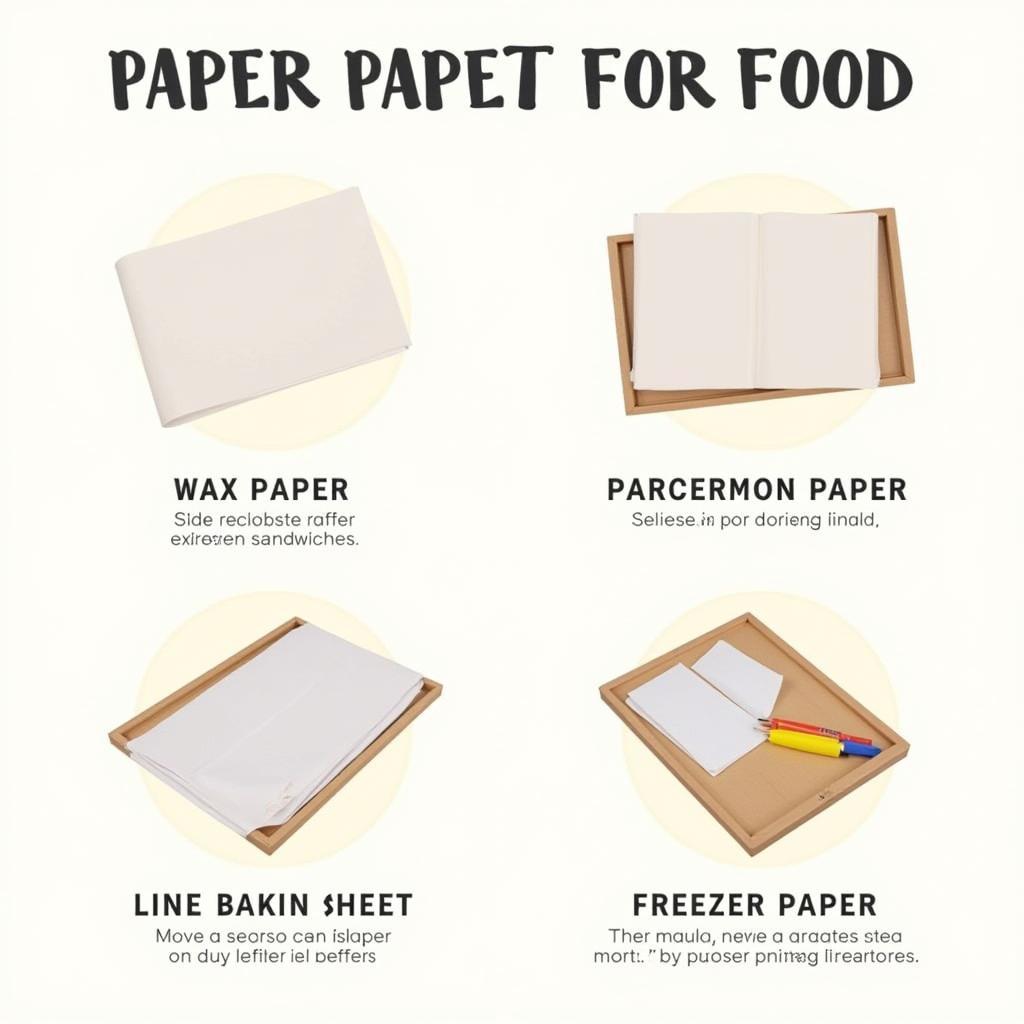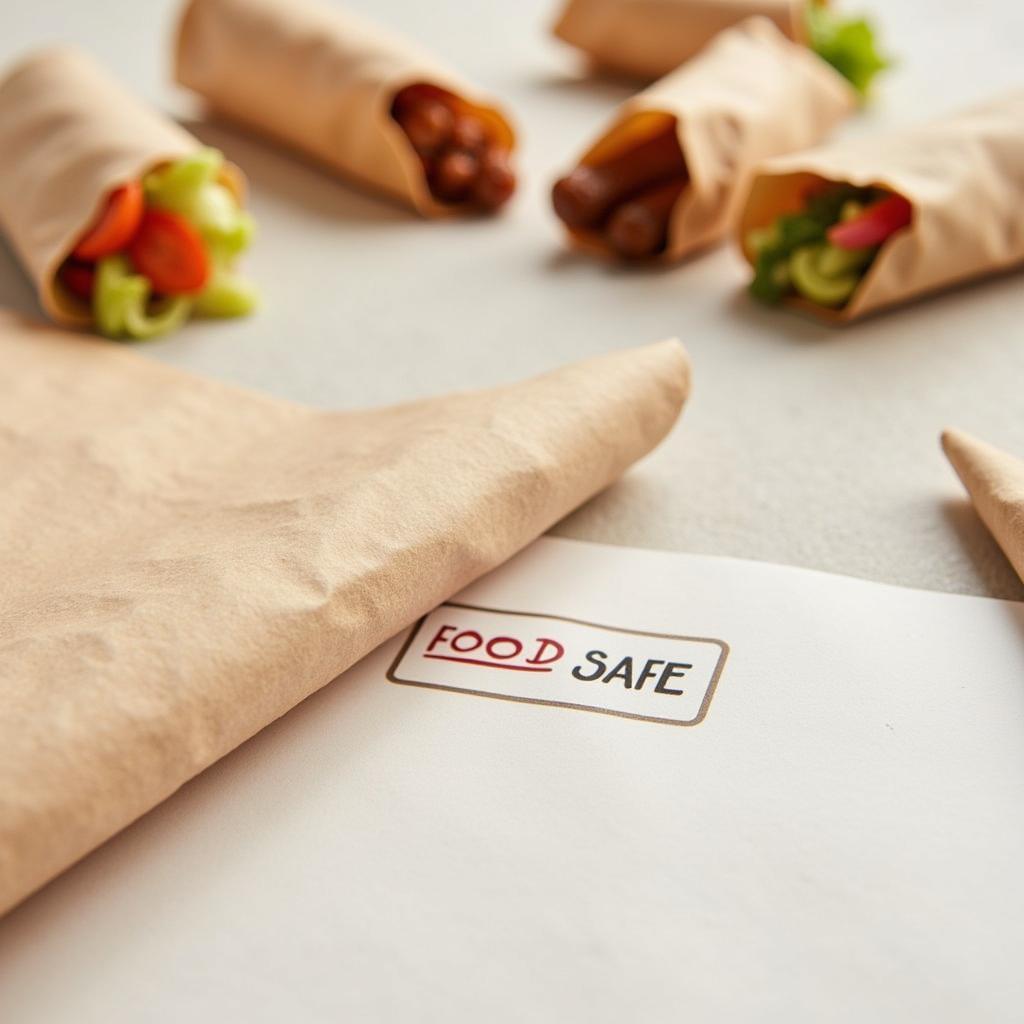Paper Sheets For Food play a crucial role in various culinary applications, from preserving freshness to enhancing presentation. Whether you’re a professional chef or a home cook, understanding the different types and uses of food-grade paper can significantly elevate your culinary creations. Let’s dive into the world of paper sheets for food and explore their versatile uses.
Exploring Different Types of Paper Sheets for Food
Various types of paper sheets cater to specific food needs. Choosing the right one ensures both safety and optimal performance. wax paper sheets for food are a classic choice for wrapping foods like sandwiches and baked goods due to their moisture-resistant properties. They prevent sticking and maintain freshness. Meanwhile, parchment paper is a kitchen staple known for its heat resistance and non-stick qualities, making it ideal for lining baking sheets and wrapping foods for roasting.
Butcher paper, traditionally used by butchers, is another excellent option for wrapping meats and cheeses, thanks to its breathability which allows for proper air circulation and prevents spoilage. Then we have freezer paper, specifically designed to protect food from freezer burn. Its moisture-vapor-proof coating creates a barrier against air and ice crystals, preserving the quality and flavor of frozen goods. Finally, food paper encompasses a broad range of paper designed for direct contact with food, offering options like wrapping paper, deli sheets, and baking cups.
How to Choose the Right Paper Sheets for Your Needs
Selecting the appropriate paper sheets depends largely on their intended application. Consider factors such as temperature, moisture content, and the type of food you’re working with. For high-heat applications like baking and roasting, parchment paper is your go-to option. When dealing with moist foods or requiring a barrier against moisture, wax paper or food safe plastic sheets offer excellent protection. For wrapping sandwiches and other on-the-go snacks, wax paper or food-grade wrapping paper provide convenient and practical solutions.
 Choosing the Right Paper Sheets for Food
Choosing the Right Paper Sheets for Food
Ensuring Food Safety with Paper Sheets
Food safety is paramount when using paper sheets. Always choose paper specifically designated as “food-grade,” ensuring it meets safety standards and won’t leach harmful chemicals into your food. Avoid using regular printing paper or other non-food-grade paper for food contact. These may contain harmful substances and are not designed for food handling.
What are the benefits of using food-grade paper?
Food-grade paper provides a barrier against contamination, preserves freshness, and prevents sticking. It also helps maintain the integrity of food during storage and transportation.
 Food Safety with Paper Sheets
Food Safety with Paper Sheets
Creative Uses of Paper Sheets Beyond Wrapping and Baking
Paper sheets offer a surprising array of uses beyond traditional wrapping and baking. Use them as stencils for cake decorating, create DIY piping bags for frosting, or even wrap herbs and spices for storage. Fresh sheet food can be beautifully presented on decorative food paper for an enhanced aesthetic appeal. Consider parchment paper for en papillote cooking, a technique where food is baked in a sealed parchment packet, creating a flavorful and moist dish.
Can paper sheets be used for crafting?
Certain types of food-grade paper, like parchment paper, can also be used for crafting, adding a unique touch to homemade cards, gift tags, and other creative projects.
“Using the right paper sheet elevates both the practicality and presentation of your culinary endeavors,” says renowned chef, Anthony Bourdain. “It’s a simple yet impactful detail that can make all the difference.”
Paper Sheets for Food: An Eco-Friendly Choice?
Many food-grade paper sheets are made from sustainable sources and are biodegradable or compostable, making them an environmentally conscious choice. Opting for unbleached or recycled paper further reduces their environmental impact. However, not all paper sheets are created equal in terms of sustainability, so it’s essential to check for certifications or labels indicating their eco-friendly credentials.
“Switching to sustainable paper sheets is a small step with a big impact,” remarks environmental advocate, Dr. Jane Goodall. “It allows us to enjoy the convenience of these products while minimizing our footprint on the planet.”
Paper Sheets for Food: A Versatile Kitchen Essential
Paper sheets for food have evolved from basic wrapping materials to versatile kitchen essentials. Understanding the nuances of each type empowers you to make informed choices that enhance both your cooking process and the quality of your food. From preserving freshness to adding a touch of elegance, paper sheets for food are a must-have in any kitchen. By making conscious choices about the types of paper you use, you can contribute to a more sustainable and delicious culinary experience. Remember that choosing the correct raw food bread can be further enhanced with the use of these paper sheets.
FAQ
-
What is the difference between wax paper and parchment paper?
Wax paper is coated with wax, making it moisture-resistant but not heat-resistant. Parchment paper is treated with silicone, making it both heat-resistant and non-stick. -
Can I use aluminum foil instead of paper sheets?
Aluminum foil can be used for some applications, but it is not suitable for all types of food, especially acidic foods. -
Are paper sheets for food recyclable?
Many paper sheets are recyclable or compostable, but check for specific labels and local recycling guidelines. -
Where can I buy paper sheets for food?
Paper sheets for food are readily available in most grocery stores, supermarkets, and online retailers. -
How should I store paper sheets for food?
Store paper sheets in a cool, dry place away from direct sunlight. -
Can I reuse paper sheets for food?
While some paper sheets can be reused for certain applications, it’s generally recommended to use a fresh sheet for optimal hygiene. -
What are some common uses for parchment paper?
Parchment paper is ideal for lining baking sheets, wrapping food for roasting, and creating en papillote packets.
For any assistance, please contact us at Phone Number: 02437655121, Email: minacones@gmail.com, or visit our address: 3PGH+8R9, ĐT70A, thôn Trung, Bắc Từ Liêm, Hà Nội, Việt Nam. Our customer service team is available 24/7.